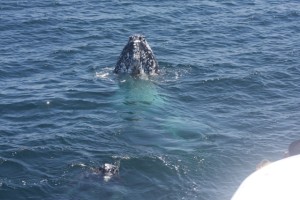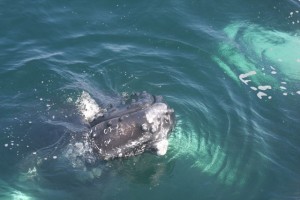Dolphin Fleet Naturalist Notebook 29 May to 4 June
To kick off Memorial Day weekend, we headed back to southeastern Stellwagen Bank on May 29th to the spot where humpback whales had been hanging around for the past few weeks. After close approaches to the boat from both Cajun and Perseid’s calves, a big splash in the distance caught the captain’s eye. We left the curious calves behind and headed toward the source of the commotion. When we arrived, nearly 20 minutes later, we found a small humpback whale with a distinctive physical feature — black flippers! Humpbacks in the western North Atlantic are usually characterized by their long, white flippers which are about 1/3 the length of their bodies. Only about 10% of the North Atlantic population has black flippers. Black flippers are in fact more characteristics of their humpback cousins in the Pacific Ocean.
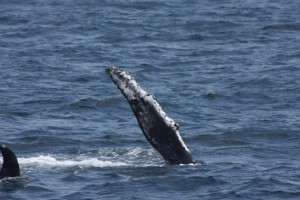
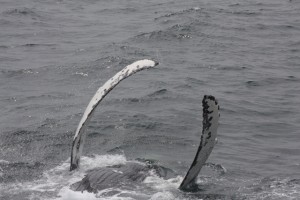
Although we were unable to ID this whale, its small size indicates that it is probably a juvenile. Its distinct body markings will help us identify this whale in the future. Later in the day, we returned to the same area to find Perseid and her calf engaging the in the same behavior. In the photos above, note not only the size, but also the differences in pigmentation between these two species.
May 30 brought us back to an area in the southeast portion of Stellwagen Bank known as the Triangle. While humpbacks were seen throughout the day, the afternoon trips were the definitive highlights. Jabiru, a humpback first seen in 2003, delighted passengers aboard the Portuguese Princess II by breaching, lobtailing, and flipper slapping. Gary Gittis, an educator who has been on repeated trips with the Dolphin Fleet, was kind enough to share one of his photos of Jabiru, shown below.
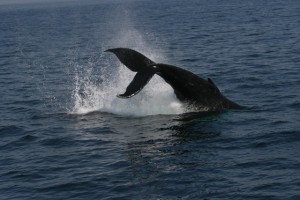
Jabiru has been seen as part of a group quite frequently for the past few weeks, but this time, he/she (we are unsure of this whale’s sex) was alone. Perhaps this acrobatic behavior was some way of communicating with other conspecifics in the area.
By evening, Jabiru had indeed rejoined with Cajun, Whisk, and their respective calves. While we don’t tend to find humpbacks in long-term, stable social structures, frequently mother/calf pairs will associate with each other or with an additional adult whale. Whisk, in particular, is a very social humpback. Last fall when she was seen nearly every day with Canopy, Milkweed, Pele and Draco.
On May 31st a haze descended over Stellwagen Bank as over 52 forest fires blazed in Quebec and northerly winds sent the smoke our way. All across New England, people could even smell the smoke from the fires! While our visibility was somewhat diminished, we found our way to a large group of humpbacks that had come together on the southern edge of Stellwagen Bank. Perseid, a female humpback whale, was accompanied by her tiny calf. Since their arrival several weeks ago, we’ve noticed that Perseid’s calf has several scars along its back that appear to the be the result of a ship strike. While it is normal for humpback whale calves to have some scratches on their bodies resulting from close contact with their often barnacle-encrusted moms, these injuries appear to be deep enough to indicate a ship strike. This reminds us of the importance of safe boating tactics when in areas where whales can be found. Our boats take great care to move carefully and slowly when whales are in the area to help prevent potentially injurious collisions. However, to date, ship strikes remain a major cause of death among humpback whales and recreational and commercial vessels are encouraged to exercise caution and responsibility when moving through whale habitats.
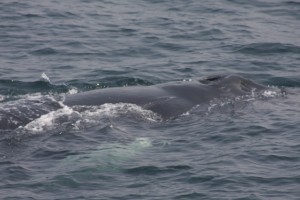
By mid-day the winds had shifted to the south, clearing the skies of most of the morning haze. This dramatic wind shift also brought an unexpected visitor to the Dolphin VIII today. A small songbird, apparently blown off course, perched aboard a pole on the fly bridge this afternoon.
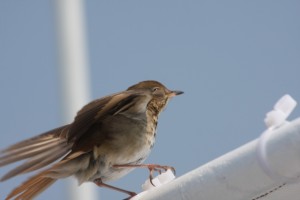
Sometimes very windy days bring terrestrial birds out further than they expect, and they land on our boats to rest before attempting to return to land. We try not to disturb them as they need to save their energy for their trip back to shore.
Increasing winds throughout the day on June 1st meant that only one boat went out to Stellwagen Bank, however, despite the increasingly rough seas, the Portuguese Princess II was able to get in a solid day of whale watching. The day began with an unidentified flipper slapping humpback, and was followed by Cajun’s calf breaching away as well. We don’t know exactly why whales breach, but sometimes it seems as though rougher seas cause these whales to leap out of the water a little bit more frequently than normal. Sure enough, Cajun’s calf breached several times before settling back down to rejoin its mother. Cajun’s calf is one of our favorite humpback whale this year as she is one of the few calves that seems to consistently fluke. We photograph the under side of this little whale’s tail so that we can recognize him/her when he/she returns next year.

Cajun, named for the “spicy” pepper markings on her fluke, is a 12 year old humpback who is here this year with her second calf to date. Humpback whale females tend to give birth to their first calf when they are around 8 or 9 years old. Males on the other hand, tend to be a few years older before they first mate successfully.
Even though the fog on June 2nd drastically limited our visibility, we left the dock promptly at 10am, and luckily, the whales we had seen the previous evening hadn’t moved too far. Cajun, Whisk, and their respective calves were joined by Milkweed, another highly social humpback who seems to prefer the company of mother and calf pairs. Also in the area was a whale named Pinpoint. Scientists who study humpback whales categorize them according to the amount of white pigmentation on their flukes. Humpbacks with almost all white flukes are “1s” while those with all black flukes are “5s”. Humpbacks with a mix of both are categorized as 2s, 3s, or 4s. Pinpoint is a definite 1, with an almost all white fluke, with the exception of one white dot on the right.
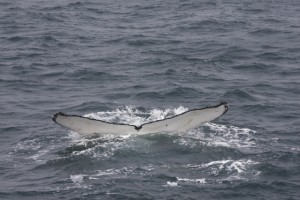
After positively ID’ing Pinpoint based on these unique fluke markings, this whale surprised everyone on board with a huge breach!
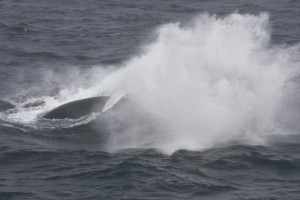
On June 3rd, the heavy fog limited us to one trip, but we were lucky again by returning to southeastern Stellwagen. The usual suspects, Whisk, Cajun, the calves, as well as Milkweed and Jabiru, were, somewhat predictably, still in the area. While it is always fun to see these animals, we were most excited today to see the Dolphin Fleet’s favorite whale, Salt. Salt is the Dolphin Fleet’s most beloved humpback because she was the first whale to be named by the late Aaron Avellar, one of the Fleet’s original captains. We first started recognizing Salt in 1975 by the unique white markings on her dorsal fin. We know that Salt is a female because she regularly returns with calves. This year, she is back with her 12th calf, a whale that has been named Zelle. Normally, calves do not get names right away, but because Salt is such a special whale, we make exceptions for her calves. Zelle is named for a highly-prized white salt derived from peat.
On June 4th, the sun had come up, and the highlight of the day included a visit from two very curious humpback whales. The humpbacks that we observe are certainly aware of our presence, and most of the time go about their business without interacting with the boat. Sometimes, to our great delight, the humpbacks become very interested in what we’re doing. Today, passengers aboard the Dolphin VIII were delighted by a pair of humpbacks who continuously swam back and forth underneath our boat, trying to figure out exactly what we were up to! The whales repeatedly spyhopped, or lifted their heads out of the water so that their eyes were above the surface! After catching a glimpse, the whales would either roll over, slap their flippers, or swim to the stern. It got to the point where we couldn’t leave the area! Although it’s not a scientific term, those of us aboard the boat call this a “mugging”.






